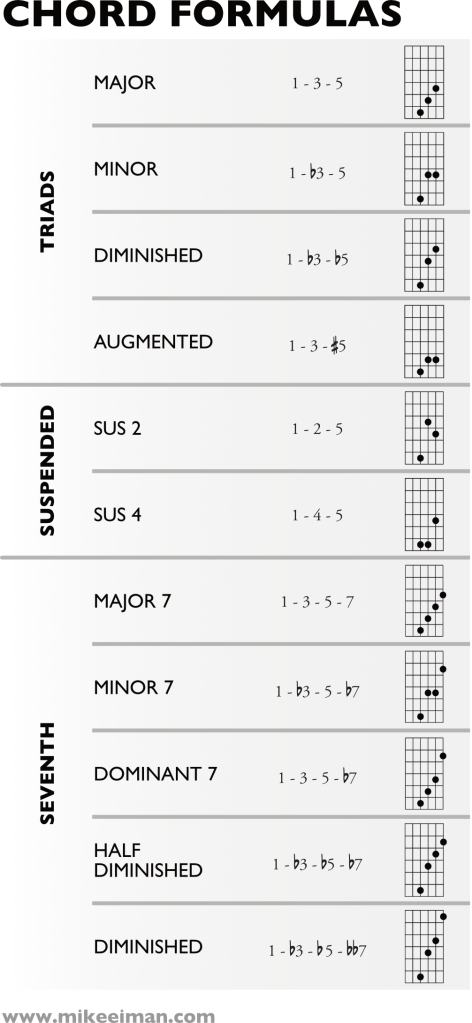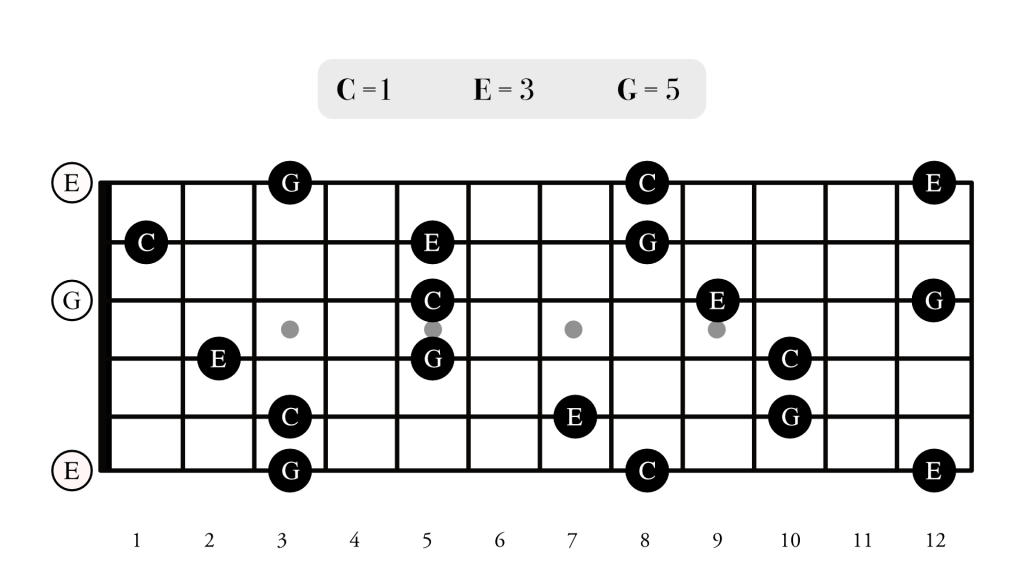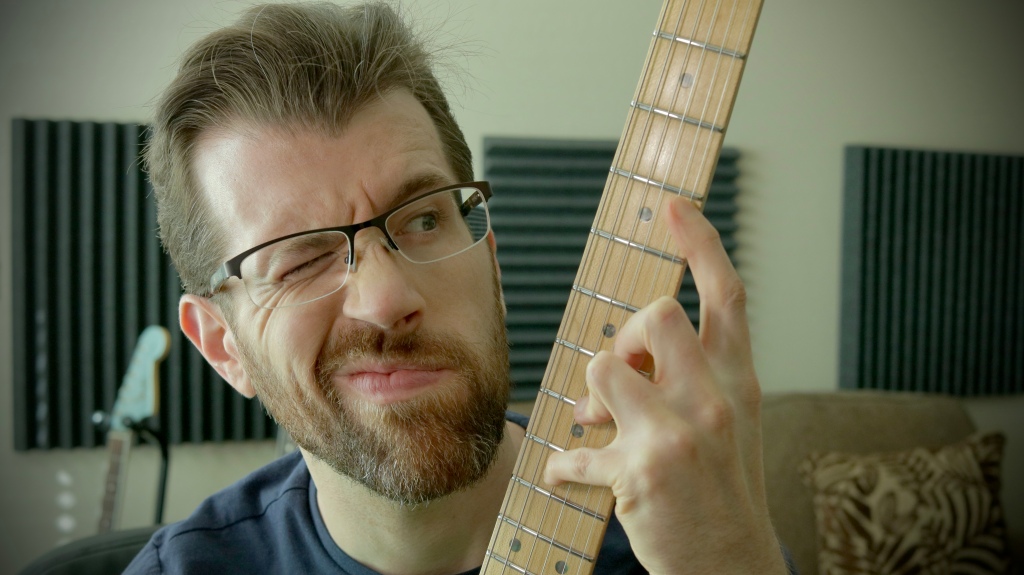Guitar players have two choices when it comes to playing chords. We can memorize lots of readymade chord shapes, or we can learn how to build chords using formulas.
So what is a chord formula?
A chord formula refers to the set of notes from a scale that are needed to construct a particular chord. The fundamental chord formula, 1-3-5, creates a major chord using the root note of a major scale. In fact, all triad chords are formed by employing some variation of the 1-3-5 formula.
What if you want to build a minor chord? Maybe an augmented or diminished chord? Then you’ll need to modify the 1-3-5 formula. It’s easier than it sounds. Let’s dive in.
How to build Basic chords

All chord formulas are based on the major scale. So before we start building any chords, you need to understand the major scale. We’ll focus on the key of C because it doesn’t have any sharps or flats.
The C major scale has seven notes. Each note is assigned a number that denotes its scale degree. The following chart gives the note names and scale degrees for C major.
| Note | C | D | E | F | G | A | B |
| Scale Degree | 1 | 2 | 3 | 4 | 5 | 6 | 7 |
Most common chord formulas are based on the 1st, 3rd, and 5th scale degrees. Using the above chart, we can build a chord with a C root that would consist of C, E, and G. That’s a C major chord.
The following diagram shows every C, E, and G on the fretboard up to the 12th fret.

If you know some basic cowboy chords and barre chords, you should be able to spot some familiar shapes in there.
These shapes will form the basis for the other chord formulas.
Here are the formulas for six common types of three-note chords. Suspended chords (Sus2, Sus4) are generally not considered “triads” because they lack a 3rd. Calling them triads also opens the door to modal triads (see more below).
| Major | 1 | 3 | 5 |
| Minor | 1 | ♭3 | 5 |
| Diminished | 1 | ♭3 | ♭5 |
| Augmented | 1 | 3 | ♯5 |
| Suspended 2 (Sus2) | 1 | 2 | 5 |
| Suspended 4 (Sus4) | 1 | 4 | 5 |
What does that mean in the real world? Let’s see what these formulas look like when we start from a C root.
| Major | C | E | G |
| Minor | C | E♭ | G |
| Diminished | C | E♭ | G♭ |
| Augmented | C | E | G♯ |
| Suspended 2 (Sus2) | C | D | G |
| Suspended 4 (Sus4) | C | F | G |
We can also add other notes to these three-note chords for a jazzier flavor. Those options include 6 chords, add-9 chords, and 6/9 chords.
| Major 6 | 1 | 3 | 5 | 6 | |
| Major Add9 | 1 | 3 | 5 | 9 | |
| 6/9 | 1 | 3 | 5 | 6 | 9 |
| Minor 6 | 1 | ♭3 | 5 | 6 | |
| Minor Add9 | 1 | ♭3 | 5 | 9 | |
| Minor 6/9 | 1 | ♭3 | 5 | 6 | 9 |
That all seems pretty straightforward. Right? What about some more complex chords like 9s, 11s, and 13s? Let’s talk about it.
Building Seventh Chords With Formulas
What happens if we start adding more notes to the formulas? Chords are typically built in thirds (using every other note in the scale).
Triads are made from 1-3-5. If we keep stacking thirds, we get to 7. More notes mean more tension.
Here are formulas for the five most common types of 7 chords.
| Major 7 | 1 | 3 | 5 | 7 |
| Minor 7 | 1 | ♭3 | 5 | ♭7 |
| Dominant 7 | 1 | 3 | 5 | ♭7 |
| Half Diminished | 1 | ♭3 | ♭5 | ♭7 |
| Diminished 7 | 1 | ♭3 | ♭3 | 𝄫7 |
What happens if we keep stacking thirds? Then we get into the realm of chord extensions.
What about extended Harmony (9, 11, 13)?
A normal guitar has six strings. Once you get beyond chords with four notes, you start running into problems. Sure you can play up to six notes at once, but the notes you want aren’t always where you need them.
This is where chord formulas become more of a suggestion than a rule. More on that later.
Here are the formulas for major, minor, dominant chords with 9, 11, and 13 extensions.
| Major 9 | 1 | 3 | 5 | 7 | 9 | ||
| Major 11 | 1 | 3 | 5 | 7 | 9 | 11 | |
| Major 13 | 1 | 3 | 5 | 7 | 9 | 11 | 13 |
| Minor 9 | 1 | ♭3 | 5 | ♭7 | 9 | ||
| Minor 11 | 1 | ♭3 | 5 | ♭7 | 9 | 11 | |
| Minor 13 | 1 | ♭3 | 5 | ♭7 | 9 | 11 | 13 |
| Dominant 9 | 1 | 3 | 5 | ♭7 | 9 | ||
| Dominant 11 | 1 | 3 | 5 | ♭7 | 9 | 11 | |
| Dominant 13 | 1 | 3 | 5 | ♭7 | 9 | 11 | 13 |
As you can see, a proper 13th chord should contain seven notes. While a pianist could easily play this chord, it won’t work for the guitar.
How to Play Long Chord Formulas On Guitar
The only way to play a seven-note chord on guitar involves dropping some notes. That’s assuming you are playing without a pianist, second guitar, or bass player to fill in some of the notes.
Which notes should you play? Which notes should you leave out?
The most important notes in a chord are the root (1), 3, and 7. The root tells us what the chord is. The third decides if the chord is major or minor. And the seventh can communicate which scale or mode we’re hearing.
The 5th of a chord adds stability, but it’s not essential to the tonality of the chord.
As long as those three notes are present (1-3-7), you are free to decide which of the other extensions to include. For example, a 13 chord should have the 13th, but it doesn’t absolutely need the 9th or the 11th.
Technically, a 13th chord needs all of the notes present to be a “true” 13th chord. These trimmed versions give us something called implied harmony. Even without all of the notes, a listener can tell what the chord is supposed to be.
What about Lydian and Phrygian triads?
I would be remiss if I didn’t cover the formulas for so-called modal triads. These are chords you might find by various names (or being discussed by Rick Beato). Truth be told, they’re not technically triads despite the colloquial name.
Maybe you’ve heard of a Lydian or a Phrygian triad. These are suspended chords that establish a “modal” sound. When you hear a Lydian triad, you know you’ve entered the Lydian mode. When you hear a Phrygian triad, you know it’s Phrygian.
The Phrygian mode has a flat 2 (or flat 9). A Sus2 chord will sound strange in the Phrygian mode because it’s actually a Sus♭2. Likewise, the Lydian mode has a sharp 4 (or sharp 11), meaning a Sus4 chord becomes a Sus♯4.
For comparison, the chart below includes the formulas for sus2 and sus4 chords alongside the two modal triads.
| Suspended 2 (Sus2) | 1 | 2 | 5 |
| Suspended 4 (Sus4) | 1 | 4 | 5 |
| Phrygian Triad (Sus♭2) | 1 | ♭2 | 5 |
| Lydian Triad (Sus♯4) | 1 | ♯4 | 5 |
Does the order of the notes matter?
Does a chord always have to have the notes in the same order presented by the formula? Not at all.
Changing the note order creates chord inversions. It’s not as scary as it sounds.
You can build a C major chord with any combination of C, E, and G. Placing the 3rd (E) in the bass results in a first inversion triad. If you put the 5th in the bass, the result is a second inversion triad.
The bigger the chord, the more inversions you can build. Chord inversions with four or more notes may be written as slash chords, which indicate a simpler chord voicing and the bass note.
Conclusion
Chord construction is an important aspect of composing and arranging music for the guitar. The layout of the instrument prevents us from playing every note of a chord.
That’s where chord formulas come into play.
This article hasn’t covered every possible chord, but it should be enough to help you figure out any chord you might need to play.
When you have to play a chart quickly without time to think, it pays to have a selection of “grips” that work for C7♭9 or A minor 13. You might not pick the best or most efficient chord for the job, but it will work.
But those grips might not help when you are coming up with your own arrangement for a song or composing an original work.
Chord formulas are a tool for the guitar player’s toolbox for solving chord-related problems.

Leave a comment